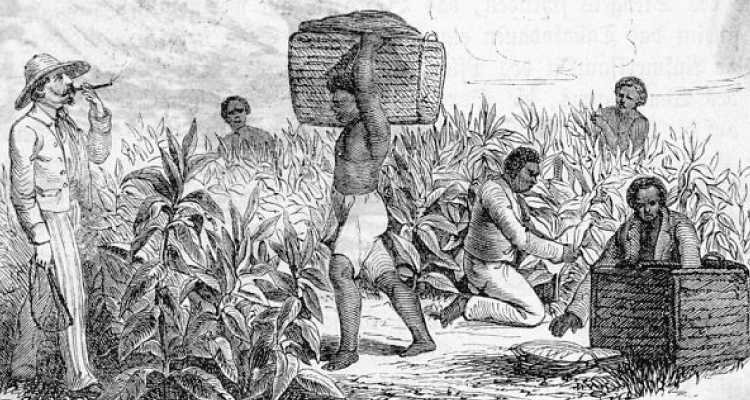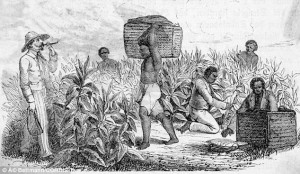The recent speech by Shashi Tharoor at the Oxford University was highly appreciated and praised. His arguments about the economic and social conditions of India during the British raj were very well placed. And he concluded by proving that Indeed, Britain owes India a lot. So, let’s understand the economic scenario of India during the colonial rule. Following are the facts that reveal the effect of colonial rule on the economy of India:
- Sectors of economy: During the pre colonial period and also during the colonial period, Indian economy was dominated by agriculture sector. The major part of the GDP came through the agricultural contribution. After the British invasion as well, the agriculture sector grew. Any change in the agriculture sector was clearly reflected on the GDP. But the composition of agricultural produce changed drastically. Earlier India exported finished goods and imported raw materials. After the changes in the agricultural policies, which were directed to grow specific crops, India became the importer of finished goods and exporter of raw materials mainly to Britain. After the World War I there was a global agricultural crisis.
Contribution of Industry to the national income was very low. Indian cotton textile Industry suffered a lot. After the industrial revolution in the Europe, production of cloth with the help of machines gave a stiff competition to the Indian cotton textiles. India not only lost its export market but also its internal demand. This critically affected the small scale industrial sector of Indian economy.
- Employment structure: There was stagnation in the composition of occupation in various sectors. Employment in agriculture was the highest with around 75%; Industry had around 10% and 15% in services. The tax system was aimed at extracting the maximum benefits out of the income of people. The zamindari system is one example. People employed were forced to pay high taxes irrespective of their agricultural produce. In order to pay the taxes people used to take loans and never come out of the payment cycles. The per capita income was very low. Slavery was highly popular in those days. During the World War I around 1,780,000 Indian men were sent from India to be a part of the British army. Among them 74,187 died and 67,000 were wounded.
- Growth: During pre world war period, the growth rate of national income was around 2%. The rate of growth of the per capita income was also positive. But, after the year 1921, i.e. when the world was moving towards the great depression, the growth was nearly 1%. And there was no growth in the per capita income. During the inter war period there was a downturn of the Indian economy. The British adopted a contractionary monetary policy during the great depression. This is a perverse behavior as during crisis, economies opt for an expansionary monetary policy. Thus British policies aimed at deterioration of the Indian economy.
These are a few indicators of British rule’s impact on Indian economy. Not only economically, but also socially British rule was a black phase for India. Lives of many people lost because of the poverty, starvation persistent in those days. Truly, Britain owes India a lot which cannot be paid in monetary terms.





30 Comments. Leave new
Good work.
very good post…
Interesting.
Very Well Written 😀
Good Work 😀
good written article!
Informative and nicely written .
Hey….Informative article and we have to look at that tym of condition and today’s condition of Indian economy….we must appreciate
Interesting read…liked it a lot!
Indeed a great article ! Well written !
good choice of topic and v.informative.
very informative!nice articulation!
well written! 🙂
Very well written and very informative 🙂
Nicely explained and really interesting!
Informative.
Good post…very interesting
Great!
Very informative articulation. Good work done. Keep it up!
thanks a lot everyone!
Very informative and nice.
A very good combination of history and economics!good work
Yes social and economical conditions during British rule were not satisfactory for the commons but if we compare it with the previous rules of India (medieval period) and from the present time then we found that British rule was not as much bad as we think..
Great work!
Thanks!
So you are comparing today’s life with that of the British raj? I think you are mistaken.. not only economically but socially the condition of India was pathetic during the British rule. For example the life expectancy at that time was less than 35 years..! It is because of the ‘drain of wealth’ from India during colonialism that we are still in the grips of poverty and malnutrition.
Yes I might be mistaken but as life expectancy concerns it was because medical science was not as developed as today , world faced wars those days , high infant mortality rates and many more reasons behind this . It was not only because of the money drainage to the Britain and it was not the situation of India only actually life expectancy was low throughout the globe those days . And as drainage of wealth concerns some of the statics says that Britishers took around one lac crores in two hundreds years whereas from the independence within around 68 years almost four hundreds lac crores of black money generated in India which is also a drainage of wealth and the reason for the poverty and malnutrition in our country. This is the comparison from the present, and from the past just go through the cruelty of the mughals . Patriotism is good and as I said before British rule was not up to the mark but much better than the mughals and a little bit better than the present…
Thank you everyone!
A very well written article, the colonial rule sucked up the complete Indian economy and the traces are seen even today
Yes. Indian’s suffered a lot while British rule. They didn’t treat us fairly.. Facts of the article were very helpful too.. Great work